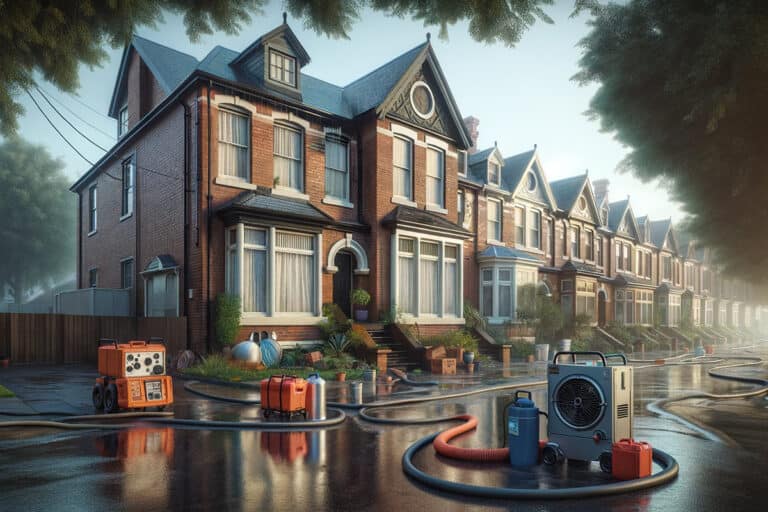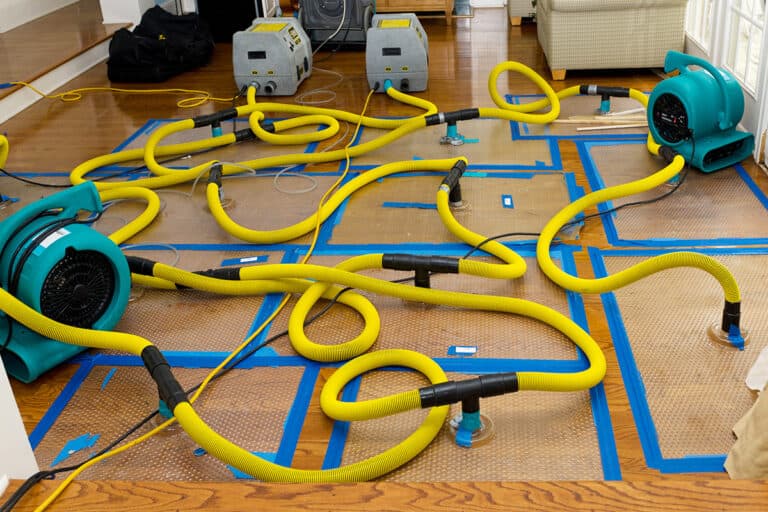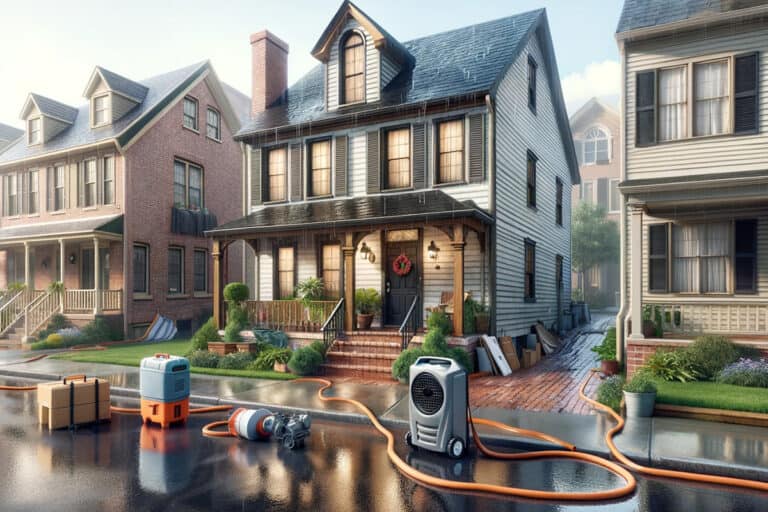Disclosure: I am compensated for purchases made through some links on this site. Click for details.
Water damage to a home or property can be overwhelming, requiring urgent remediation to prevent further deterioration. The cost of water damage restoration is variable and hinges on several factors such as the extent of the damage, the type of water involved, and the specific repairs necessary. Property owners often seek efficient restoration services that can return their space to a pre-damaged state without causing financial strain.
Understanding the intricacies of water damage restoration costs is vital for any homeowner or property manager. The process generally includes water extraction, drying, dehumidification, sanitizing, and reconstruction of affected areas. Determining the scope of water damage and the corresponding remediation steps can be complex, and it often involves professional assessment to ensure a thorough and safe restoration.
Choosing the right water damage restoration professionals and understanding the insurance coverage available are crucial steps in managing the costs and ensuring quality repairs. Preventative measures and regular maintenance could also mitigate potential risks, making it essential for property owners to be informed and prepared.
Key Takeaways
- Restoration costs vary based on damage severity and water type.
- Professional assessment is integral for accurate cost estimation.
- Choosing qualified professionals and understanding insurance are key to managing restoration expenses.
Understanding Water Damage
Water damage is an issue that property owners may face, and its severity can vary greatly. To properly assess and repair damage, one must understand the types of water involved and the extent of the damage, which is categorized into different classes and categories.
Categories of Water Damage
Category 1: This category involves clean water that is not harmful to humans and typically comes from sources like leaky faucets or broken supply lines. Category 2, referred to as gray water, contains some level of contamination and can cause discomfort or sickness if consumed or exposed to. Examples include sump pump failures or discharge from dishwashers. Category 3 water, known as black water, is grossly unsanitary and contains harmful bacteria and fungi, which can arise from sewage or external flooding.
Related Content: The 3 Categories of Water Damage: What You Need to Know
Classes of Water Damage
Class 1 damage signifies minimal absorption and water volume; it’s the easiest to deal with. Moving up to Class 2, there’s significant absorption into flooring and structural materials. Class 3 is when water wicks up walls, possibly soaking insulation and furniture, while Class 4 pertains to special drying situations with materials like hardwood and concrete that have deep saturation.
Assessing the Damage
Proper assessment of water damage is crucial to determine the course of action for restoration. This evaluation categorizes the damage by type and severity, shaping the restoration plan and cost estimation.
Type of Damage
Water damage can manifest in various forms. Structural damage affects the integrity of the building, requiring in-depth inspection to ensure safety. Cosmetic damage, while less critical, impacts the aesthetics of the property and may involve replacing materials like drywall, paint, and flooring. In cases involving electrical damage, safety is paramount; experts must meticulously evaluate the electrical system before beginning repairs. Each damage type requires a specific approach and expertise to restore the property to its pre-damage condition.
Severity of Damage
The severity of water damage dictates the scope of restoration efforts. Minor severity might entail surface-level repairs, while major severity could mean extensive reconstruction. Structural damage is often indicative of significant severity, potentially leading to comprehensive rebuilding to ensure the building’s stability. Conversely, cosmetic damage typically signifies a less severe impact, often remediable through cleaning, repainting, or refinishing. It’s essential to evaluate every aspect meticulously, as overlooked damage can lead to future safety and financial concerns.
Health and Safety Considerations
When dealing with water damage restoration, health and safety are paramount and should not be overlooked. The presence of mold can initiate within 24-48 hours of water exposure, which can cause allergic reactions and respiratory issues. Therefore, it is crucial to address water damage promptly to avert mold proliferation.
The type of water involved in the damage plays a significant role in determining the potential health risks. Clean water from sources like leaky faucets carries minimal health risk, whereas black water, typically from sewage or floodwaters, is teeming with harmful bacteria and microbes, necessitating professional attention.
Here is a concise rundown of safety measures:
- Immediate action to dry out areas to prevent mold growth
- Proper use of personal protective equipment (PPE) when handling contaminated water
- Ensuring thorough cleaning and sanitation of all affected surfaces
It’s essential that health and safety protocols are followed diligently, and often, this may mean calling in certified restoration professionals. They are equipped to handle various water damage scenarios safely and efficiently, reducing potential health hazards.
Water Damage in Different Areas
When water damage occurs, the impact can vary significantly depending on the location within a property. Each area has unique challenges and potential costs, making it crucial to address these issues precisely.
Ceilings and Walls
Water damage to ceilings can manifest as discolored spots or sagging, indicating trapped moisture that can lead to mold growth if not promptly addressed. With walls, particularly those made of drywall, water exposure can result in swelling, warping, or even complete structural compromise. Damage assessments should be conducted immediately to prevent further degradation.
Floors and Basements
Floors are susceptible to water damage, especially when made of materials that absorb moisture, such as hardwood or carpet. The repercussions can lead to buckling, staining, or the formation of mold beneath the surface. In basements, the risks are even greater due to potential flooding, which can necessitate extensive water extraction and dehumidification procedures to prevent long-term damage to foundations and interior spaces.
Roof and Insulation
The roof is the primary shield against environmental water exposure; damage here can lead to leaks that compromise the integrity of the entire structure. Water-damaged insulation within attic spaces loses its thermal resistance and can become a breeding ground for mold, necessitating not only water removal but also replacement of insulation to restore the property’s energy efficiency.
Water Damage from Various Sources
Water damage restoration costs are influenced significantly by the source of water damage. It’s essential to understand the distinct challenges and processes involved depending on whether the damage is due to plumbing issues or flooding.
Plumbing Issues
Plumbing systems can fail due to frozen pipes, leaks, or pipe bursts, leading to significant water damage. Plumbing issues usually involve clean water, but can swiftly escalate if not addressed, causing more extensive damage and higher restoration costs. Identifying and rectifying these issues promptly helps to minimize the destruction and restoration expenses.
Flooding and Weather
Flooding and weather-related water damage often have far-reaching consequences for properties. They typically deal with contaminated water, which requires not only water removal but also extensive cleaning and sanitization. The costs for these restoration efforts can increase due to the presence of sewage backups, hazardous materials, or the need for structural repairs.
Restoration Process Overview
The restoration process for water damage typically begins with an urgent response to address the immediate issues and prevent further damage. Meticulous attention is then devoted to identifying and eradicating mold, often resulting from water incidents.
Emergency Response
Immediately following the discovery of water damage, a team of professionals must be dispatched to stabilize the area. The primary goals include stopping the source of water, extracting standing water, and commencing the drying process to minimize decay and distortion of building materials.
Mold Remediation
If prolonged moisture is present, mold growth is likely and must be addressed as part of the water damage restoration process. Specialized teams will assess mold presence, contain the affected area, and use advanced techniques to remove mold, ensuring a safe and clean environment post-restoration.
Calculating Restoration Costs
When estimating the cost of water damage restoration, one must consider various factors that contribute to the overall expense. The size of the affected area significantly influences the total cost, ranging from $18.78 to $37.52 per square foot as per the latest figures. Accurate calculations are crucial for homeowners to understand potential expenses.
Labor costs also play a pivotal role, often fluctuating based on the project’s complexity and the restoration professionals’ expertise. Typically, water damage restoration services bundle labor charges within the quote, with national averages falling around $3,455, though this amount can vary. For a clear budget estimate, one should obtain multiple quotes from reputable service providers.
Seeking budget-friendly options without compromising on quality is advisable for those concerned with keeping expenses in check. While some may offer lower initial quotes, comprehensive services from certified professionals may prevent additional costs later on. It’s essential to balance affordability with the necessity for a thorough and durable repair to protect one’s property.
Insurance and Documentation
When dealing with water damage restoration, homeowners should review their insurance plans carefully. Coverage for water damage may vary depending on the cause, such as weather-related flooding or internal issues like pipe bursts. Policyholders need to understand the specifics of what their insurance covers.
Documentation is crucial in the claims process. Homeowners should meticulously document all damages with photographs and detailed notes. This evidence supports the claim and assists in receiving a fair assessment from the insurance company.
Here is a simplified checklist for insurance and documentation:
- Contact the insurance company immediately to report the damage.
- Keep a detailed record of all communication with the insurance provider.
- Document all damaged property before any cleaning or repairs begin.
Claims for water damage can be complex, and prompt action can be a decisive factor in the resolution timeline. Homeowners should file their claims as soon as possible with all the necessary documentation. Insurance providers often require a proof of loss statement, which should be prepared with accuracy and attention to detail.
In some cases, insurance companies may dispute claims. Policyholders should be prepared to negotiate or seek the help of a professional claims adjuster if necessary. Complete and accurate documentation can strengthen their position in such disputes.
Factors Affecting Restoration Costs
The cost of water damage restoration can be influenced by various factors ranging from the types of materials and fixtures that need repair or replacement to the extent of the damage that has occurred. Homeowners need to understand these factors to set realistic expectations for the financial implications of restoration.
Materials and Fixtures
The quality and type of materials and fixtures impacted can significantly affect restoration costs. Subflooring and structural materials such as beams and joists are foundational to a home’s integrity and can be costly to repair or replace. High-end bathroom fixtures or custom items like unique tiles or premium faucets will also increase the overall costs due to their higher initial prices and potential installation complexities.
Extent of Damage
When assessing the extent of damage, two crucial aspects come into play: severity and coverage area. Minor leaks affecting a small section of the subflooring may incur lower costs, while widespread water intrusion affecting multiple rooms and key structural materials could lead to substantial repairs. Moreover, if bathroom fixtures or other specific room elements are extensively damaged, this can elevate costs, more so if mold remediation or major structural rebuilds are necessary.
Choosing a Restoration Professional
When dealing with water damage, selecting a reputable restoration professional is critical. They should offer a range of services aimed at addressing various water damage scenarios. The decision should be based on their qualifications, availability, and customer feedback.
Qualifications and Certifications:
- Ensure they are certified by a recognized industry organization such as the Institute of Inspection, Cleaning and Restoration Certification (IICRC).
- Professionals should be licensed and insured to protect homeowners from liability.
Availability:
- 24/7 emergency services are vital since water damage can occur at any time.
- Prompt response times minimize further damage and restoration costs.
Customer Reviews and Experience:
- Check for positive reviews and a proven track record.
- Reviews often reflect the reliability and quality of the service provided.
Services Offered:
| Type of Service | Description |
|---|---|
| Inspection | Comprehensive assessment of damage. |
| Water Removal | Efficient extraction of water. |
| Drying | Complete drying of affected areas. |
| Restoration | Repair and restoration of property. |
Homeowners should also consider the techniques and equipment used by the restoration professional. Advanced technology implies a more thorough and efficient restoration process. A reliable professional will guide them through the restoration steps, ensuring transparency and clarity.
Preventative Measures and Maintenance
When considering the prevention of water damage, routine maintenance of plumbing systems is crucial. Inspecting pipes, faucets, and connecting hoses regularly for signs of wear and leaks can save homeowners from costly water damage repairs. A homeowner should schedule these inspections annually to mitigate risk.
Bathroom fixtures should be monitored for constant drips or pooling water, which could indicate a seal failure. They should look for discoloration, warping, or a musty odor, as these are early signs of mold growth and should be addressed promptly. Regular cleaning and drying of shower areas and sinks help in keeping mold at bay.
For areas prone to moisture, like basements, using a dehumidifier can help control humidity levels, thus deterring mold formation. Ensuring that gutters and downspouts are clear of debris will direct water away from the property’s foundation. A well-maintained exterior drainage system is a defense against water seepage.
In summary, homeowners can often prevent significant water damage and mold growth by adopting a regular maintenance schedule. They should stay vigilant about their property’s plumbing and bathroom fixtures to catch issues early. Proactive measures and swift action in the event of water exposure are key to preventing extensive damage and the associated high costs of restoration.
Conclusion
Water damage restoration costs can vary widely depending on several factors, such as the extent of damage and the type of water involved. Homeowners might encounter a range of expenses, typically starting from as low as $200 for minor repairs to up to $100,000 for severe class four damage. Interested parties should prepare for these potential costs by conducting thorough research and considering the specifics of their situation.
Professionals categorize water damage into different classes and categories, influencing the restoration expense. Restoration for “gray water,” which contains mild contaminants, averages between $4 and $6.50 per square foot. It is crucial for property owners to quickly address water damage to prevent additional issues such as mold, which can compound restoration expenses.
Homeowners are encouraged to consult with expert restoration services to get a precise quote tailored to their unique circumstances. Companies like Water Damage Advisor and Forbes provide valuable insights into potential costs. By understanding the variables and planning accordingly, individuals can manage the financial aspect of water damage restoration more effectively.





